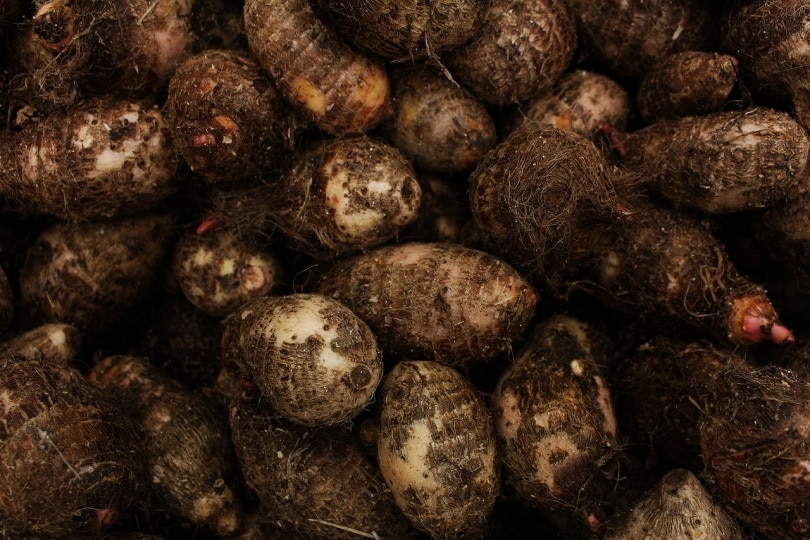Can Cats Eat Cool Whip? What You Need to Know!
By Ashley Bates
Updated on

Cats can eat some pretty crazy things. Whipped cream might not strike you as a huge problem factor when it comes to feline consumption—and you’d be right. Aside from the fact that cats can’t even taste sweet flavors, Cool Whip doesn’t have any ill effects on your cat after just a lick or two.
In fact, it’s not toxic for cats, and isn’t too harmful unless they eat so much they make themselves sick. But let’s face it—Cool Whip really isn’t healthy for any creature, us included! Let’s go over exactly what is in Cool Whip, why a cat can’t taste it, and what to do if they eat it.
Whipped Cream Nutrition Facts
Amount Per: 1 tbsp
| Calories: | 25 |
| Fat: | 2 g |
| Sodium: | 2 mg |
| Carbohydrates: | 1.8 g |
| Protein: | 0.4 g |
| Calcium: | 1% |
We all know that Cool Whip is comprised of mostly sugar, serving as a tasty topper to some of our dessert favorites. Our pies would be naked without it.
But we also know that Cool Whip isn’t inherently healthy. A once-in-a-while snack is fine, but not necessarily often. For your cat, it should be even less often than that. It offers absolutely no nutritional benefit to your cat.
Whipped Cream: Points to Touch On
Depending on brand and recipe, the first few ingredients of whipped cream usually include skim milk, hydrogenated vegetable oil, high fructose corn syrup, and water.
Sweeteners
Some diet and light whipped creams might contain artificial sweeteners, which could be toxic to cats. Sweeteners like xylitol have insulin-releasing properties, which can cause your cat to get hypoglycemia.
While most of the time, xylitol won’t be prevalent enough in Cool Whip to cause any real side effects, it’s best never to take chances. Even a small amount of xylitol can cause liver failure in cats.
Sugar
A less lethal but certainly mentionable ingredient in Cool Whip is sugar—labeled often as high fructose corn syrup, cane sugar, glucose, dextrose, and sucrose. Sugar content is significant in whipped cream. You can almost always find it in the top handful of ingredients on the label.
While a little won’t hurt, too much sugar over time can aid in obesity and other health concerns that can be a real problem for aging cats.
Dairy
Since cats are naturally lactose intolerant in almost all cases, dairy isn’t a good option. Even though old movies and grandparents tell us that kitties love nothing more than a dish of warm milk, and their taste buds may agree, their bodily systems do not.
Cats don’t make the proper enzymes to digest dairy items that contain lactose like cheese, milk, whipping cream, condensed milk, or yogurt. A little probably won’t hurt, but larger portions can cause a gastrointestinal disaster or distress for your feline.

Cats Are Unable to Taste Sweetness
In the wild, cats are obligate carnivores, which means they rely solely on animal matter for survival. Aside from munching on the occasional houseplant, domesticated cats don’t need anything that comes from plants.
Sugar comes from the sugarcane plant. Since it comes from a plant, cats never met this taste until after domestication. They don’t have proper taste receptors to sense the flavor of sugar. They simply never needed the taste receptors associated with those flavor tones.
If you see a cat munching on a sugary food item, it’s much more likely another ingredient or the texture of the item they are attracted to.
Ingredients Matter
Cats eating your Cool Whip might be completely unimportant in relation to whatever else your cat got into. Many holiday desserts or bakery goodies contain other questionable ingredients that can be harmful on their own.
Here is a quick list of common pairings you see with whipped cream, along with the toxicity information:
- Alcohol—cats cannot handle alcohol in any quantity
- Chocolate—caffeine and theobromine are stimulants that have negative impacts on your cat’s digestion
- Coffee—also containing caffeine, coffee can release a dangerous chemical in bean, ground, or brewed form
- Citrus fruit—citrus fruits contain limonene and linalool, which are toxic to cats
- Dairy—most cats are lactose intolerant, so dairy causes gastrointestinal upset
- Grapes/raisins—grapes are one of the most toxic foods a cat can own, causing kidney failure in some cases
- Certain nuts—nuts like almonds, pecans, and walnuts are harmful to a cat, which can lead to pancreatitis
- Certain spices—cabinet favorites like cinnamon and nutmeg are toxic to cats, so be careful
If you think your cat consumed a potentially irritating or toxic ingredient that isn’t whipped cream, please call your vet right away for further direction and guidance.
What You Should Do If Your Cat Eats Cool Whip
If your cat eats a little dollop of Cool Whip, they will be no worse for the wear. You only need to worry about Cool Whip if it contains xylitol, an artificial sweetener.
Once you check the ingredients and get the okay, your cat should recover just fine, even if they can’t taste it.
Now that you know what you can safely feed your cat, it’s just as important to find a bowl that supports their health and well-being. With whisker-friendly bowls and a wide tray to catch any spills, our Hepper NomNom Cat Bowl is our favorite option.
Cats + Cool Whip: Final Thoughts
If your cat sat lapping up the Cool Whip on your paper plate, you can relax. Again, take a quick sweep over the ingredients and consider what else they might have eaten. If all looks normal, you shouldn’t notice any adverse effects.
However, if your cat ate some dessert with a more sinister ingredient, it might warrant a vet trip if your cat exhibits symptoms.
Related Reads:
Featured Image Credit: fvk, Pixabay













